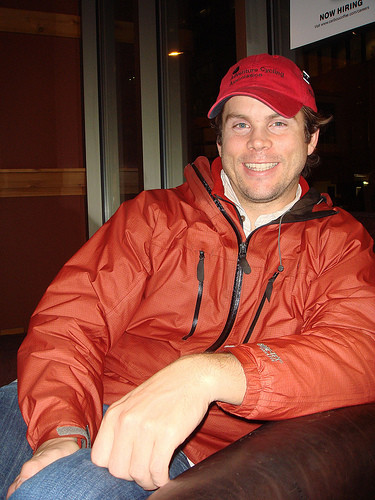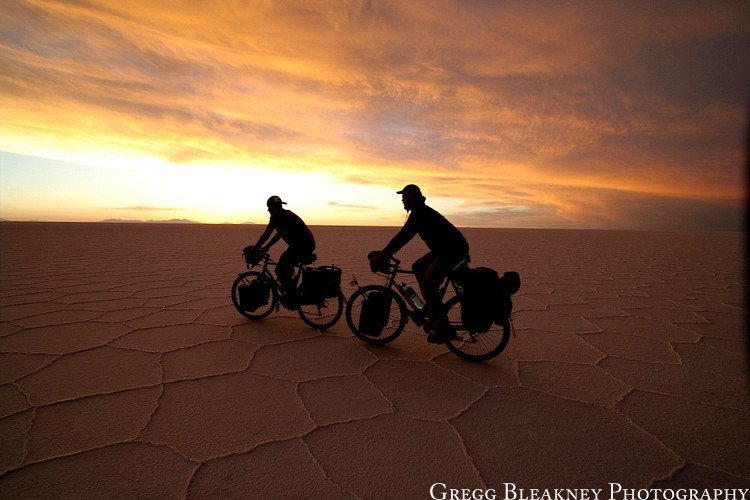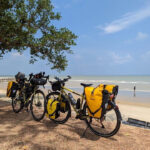Gregg Bleakney was on a conventional path to success in the early 2000s. A comfortable six-figure salary as a software salesman, a house in Seattle – life was unfolding as expected. However, a pivotal decision to embark on a two-year bike tour from Prudhoe Bay, Alaska, to Tierra del Fuego, Argentina, with his college friend, would dramatically alter his trajectory. This journey, initially intended to raise funds for the American Diabetes Association, became a catalyst for a profound career shift. By the ride’s end, Gregg knew he couldn’t return to his former life. He traded his corporate job and Seattle home for a life of adventure, becoming a visual storyteller specializing in adventure travel, often centered around bikes. Currently traversing the globe as a photographer and writer, Gregg took a brief pause in the US after covering the Tour de Langkawi in Malaysia to share his story. We discussed his transformative Alaska to Argentina bike tour, his new career, global travels, and the bikes that have been central to his journey.
What sparked the initial idea for your transformative Alaska to Argentina bike tour, the trip that set you on this new path?
Initially, it was about taking a year-long sabbatical from my software sales career. I envisioned returning with fresh energy, ready to climb the corporate ladder. I had been working in that field for a while and felt I needed a break. That was the simple starting point.
My introduction to cycling came through injury rehabilitation. I was recovering from a knee injury from track and field – I used to compete in the triple jump. During this time, I met someone at a coffee shop who told me about a person cycling through Mexico. The idea of bike touring was completely new to me. I found this bike tourist online and followed his trip reports, I believe on a Yahoo Groups forum. This exposure played a significant role in my decision to undertake my own bike tour.
The plan materialized with my best friend from college, Brooks. We began the journey together and cycled through Mexico. However, near the Guatemalan border, we were assaulted by rebels in a terrifying incident. This traumatic experience led Brooks to reconsider continuing. We both struggled with post-traumatic stress afterwards. Our families came to meet us, and Brooks, who was engaged at the time, decided it was wiser for him to return home and stop the trip. I chose to continue on my own.
Gregg Bleakney crossing from Argentina to Chile on his bike. A self-portrait by Gregg Bleakney showcasing the adventurous spirit of his bike tours.
After Brooks left, it became a solo journey, and the entire dynamic shifted. The ride ended up taking two years, and towards the end, I realized that returning to my old job was no longer an option. The nine-to-five technology career simply didn’t align with my mindset after two years on the road.
During the journey, I acquired a camera and started taking photographs. I met incredible photographers in various locations and sought their advice on photography and the photographer’s lifestyle. At the end of my trip, I received a scholarship from Rich Clarkson, former Director of Photography at National Geographic, to attend a workshop. Meeting renowned National Geographic adventure photographers there further inspired me to pursue a photography career instead of returning to my old job. That’s the essence of my two-year bike trip and its impact.
Beyond using cycling for knee rehab, did you have a strong cycling background or bike touring experience before embarking on this major tour with your bikes?
It had been a few years since my knee injury, and I had started participating in Team in Training century rides, which involved raising money for charity and cycling a hundred miles. I did several of these and became quite invested in training. My background was in high-intensity, competitive athletics from my track and field days where I was training for the Olympics. That summer, I participated in around 20 weekend 100-mile endurance races across California, where I was living then. I remember being very competitive, trying to outperform everyone on every hill, always pushing myself to the limit.
Thankfully, my friend Brooks introduced me to a different kind of cycling. He was doing a longer, multi-day fundraising ride down the California coast to raise money for AIDS. I joined him, and this ride was more about connecting with people and enjoying the experience. He raised a significant amount, but we later discovered that a large portion went to event organization rather than the charity itself. So, the following summer, we decided to organize our own ride down the coast from Seattle, my hometown, to San Francisco, his hometown. We raised money independently to donate to a charity of our choice. His mother had recently passed away from diabetes, so we chose the American Diabetes Association.
That was my first long-distance bike ride.
Later, I attended a talk at REI by a man who had cycled from Alaska to Argentina over ten years in segments. We became friends, and he invited me to join him on the northernmost section from Prudhoe Bay to Fairbanks, which he hadn’t yet completed. I joined him, and he taught me about wilderness camping. I had never camped before that trip.
This experience was a year or two before I started my own Alaska to Argentina ride, so I’ve actually cycled that section twice. It’s a bit unusual, not many people ride the Prudhoe Bay road twice.
A photograph from The Daily Randonneur, showcasing the spirit of long-distance cycling and bike adventures.
Your career now involves global travel covering bike races and various adventures, both cycling and beyond. What are some of your most memorable assignments and favorite destinations you’ve experienced with your bikes or through your photography?
Colombia holds a special place for me. It’s the only country I skipped on my Alaska to Argentina trip. Back in 2005, the safety of cycling through Colombia was questionable. However, I later met Colombians in Peru who invited me to visit their country.
I’ve now been to Colombia five times, most recently last month. I’ve spent considerable time with Colombian cycling teams. It’s unique as one of the few developing nations consistently producing world-class cyclists. These athletes emerge from unexpected places and excel in European cycling.
I met a cyclist who was on the Café de Colombia national team. He bought his first bike with earnings from working in coal mines in a small Colombian mining town. I wrote a story for Bicycling Magazine and visited his hometown with him. We went down into the coal mines, 600 meters underground, navigating shafts only three or four feet tall. His former coworkers and coach were still working in the mines. The air quality was terrible, making it hard to breathe. It was a very challenging environment. Many of the miners are also competitive bike racers on weekends, with their own miners racing team. That story remains one of my most impactful experiences.
Another recent highlight was getting media credentials to photograph the Tour Down Under from a helicopter. Aerial photography over a cycling peloton is rare. Seeing the race from above provides a unique perspective and context. Witnessing the vast, stunning landscape of a bike race from that vantage point was an incredible project.
Your work seems incredibly diverse, ranging from commercial projects to bike race coverage and other adventures. Do you have a preferred niche within adventure travel and photography, perhaps something specifically related to bikes?
In my first couple of years, most of my assignments were cycling-related. But I realized it was less about cycling itself and more about the spirit of adventurous travel. The bike is essentially a tool for exploration. I’d say my niche is adventure travel with a bicycle. However, I am actively expanding beyond that and exploring other areas. I’ve recently been involved in investigative conservation work, which has been very rewarding. An article about that will be published soon.
It’s worth noting that cycling is unique among major sports in truly showcasing travel through landscapes and destinations. There’s no enclosed arena. You’re out in the world, moving through it. That’s why I’m drawn to covering professional cycling, specifically stage races that traverse diverse locations.
What destinations are still on your travel and cycling bucket list?
Africa, particularly concerning cycling, is a region that greatly interests me right now. Green Edge, an Australian pro cycling team, signed Daniel Teklehaymanot from Eritrea, the first black African cyclist on a pro continental team. He believes there are many cyclists in Africa who are as talented or even more so.
The UCI is aiming to globalize cycling by hosting races in China, India, and across Asia and by recruiting cyclists from Africa. My next potential project, possibly this year, is to go to Africa to assess the talent pool and the potential for African cyclists in professional cycling. In track and field, East African runners from Kenya and elsewhere have proven their exceptional cardiovascular capabilities for long-distance running. However, running and cycling are very different disciplines, so it will be interesting to see.
Gregg Bleakney and Brooks, captured on their bikes during their transformative “Ribbon of Road” bike tour. Photo by Gregg Bleakney.
How do you feel about the nomadic lifestyle? Do you find it challenging to be away from a permanent home so frequently?
I recently rented an apartment, though I’m still waiting for my bed and currently sleeping on an air mattress. I’ve been living nomadically since 2005. I once tried to count the number of beds I’ve slept in and it’s definitely over 1000 in the last few years. There’s an allure to being a nomad, but as my career advances, managing everything on the road has become more difficult. Post-assignment work, like photo editing, writing, interviews, and research, requires a dedicated workspace.
In the initial years, a nomadic lifestyle was essential for me. To be an adventure photographer and travel writer, you need to be out experiencing adventures and traveling. But I’ve reached a point where complete nomadism is no longer sustainable. This new phase, having an apartment, is something I appreciate. I likely won’t be there often, but it’s comforting to have a home base to return to.
Do you ever envision returning to a traditional nine-to-five routine in a fixed location?
I don’t see myself ever returning to a nine-to-five job. My current goal is to continue building my career. In the past year, I’ve shifted from calling myself a photographer to a “visual storyteller.” I’ve been expanding into writing and video as well. I want to continue developing this. I believe there’s significant opportunity for this type of storytelling, and people are starting to value and pay for it.
What projects are you working on for 2012?
2012 has been an incredible year so far. I actually needed to dedicate this month to rest. I’ll be heading back to Europe soon, likely covering the Giro d’Italia for the second consecutive year. Then, I’ll return to Colombia for two different projects. Towards the end of the year, I’m planning to do some work in Africa. These are some of the major projects I’m looking forward to, but I’m also excited to spend more time in the US this year. It sounds unusual, but I’m eager to organize my files. I have terabytes of files stored and backed up on drives, some at friends’ houses, some at my parents’. Consolidating and organizing everything will be great.
Is there anything else about your adventurous life that you’d like to share?
It’s been an extraordinary journey. Looking back at what I was doing just a few years ago compared to now feels surreal. It’s definitely a life transformation.
I frequently receive emails from people asking for advice on planning long bike rides or trips. The most common initial questions are about bike types and gear. However, I try to encourage people to look beyond the equipment and consider how a year or two on the road can change their life. There’s much more to it than just gear. Being on the road for two years profoundly changed me. I encourage everyone, especially Americans, to consider taking a break, leaving their routines for a year or so, and traveling. The benefits are immense.




